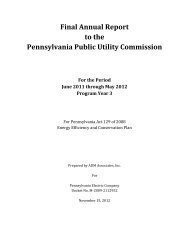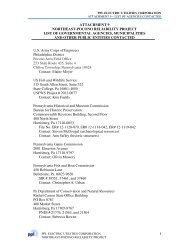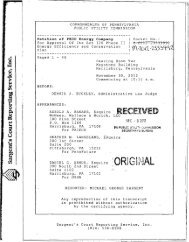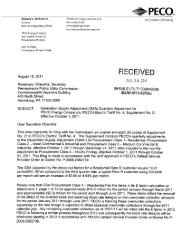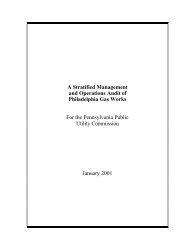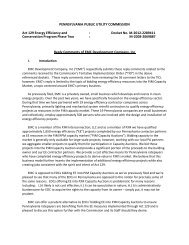Reliability Report -- 1999 - Pennsylvania Public Utility Commission
Reliability Report -- 1999 - Pennsylvania Public Utility Commission
Reliability Report -- 1999 - Pennsylvania Public Utility Commission
You also want an ePaper? Increase the reach of your titles
YUMPU automatically turns print PDFs into web optimized ePapers that Google loves.
trees. This analysis is helpful in identifying the primary causes of service interruptions and determining<br />
which causes, if any, can be prevented in the future through proposed solutions.<br />
The regulations require EDCs to report reliability performance on a system-wide basis, rather than on an<br />
operating area basis, and provide an analysis of the worst performing five percent of circuits and major<br />
remedial efforts to improve those circuits.<br />
Major Events<br />
In order to analyze and set measurable goals for electric service reliability performance, outage data is<br />
separated into normal and abnormal periods so that only normal event periods are used for calculating<br />
reliability indices. The term “major event” is used to identify an abnormal event, such as a major storm,<br />
and is defined as either of the following:<br />
• An interruption of electric service resulting from conditions beyond the control of the EDC<br />
which affects at least 10 percent of the customers in the EDC’s service territory during the course<br />
of the event for a duration of five minutes or greater; or<br />
• An unscheduled interruption of electric service resulting from an action taken by an EDC to<br />
maintain the adequacy and security of the electrical system.<br />
Outage data relating to major events are to be excluded from the calculation of reliability indices. In<br />
order to avoid the inappropriate exclusion of outage data, the <strong>Commission</strong> has implemented a process<br />
whereby an EDC must submit a formal request for exclusion of service interruptions for reporting<br />
purposes, accompanied by data which demonstrates that a service interruption qualifies as a major event.<br />
Benchmarks and Standards<br />
The performance benchmark represents the statistical average of the EDC’s annual, system-wide,<br />
reliability performance index values for the five-year time period from 1994-98. The benchmark serves<br />
as an objective level of performance that each EDC should strive to achieve and maintain and is a<br />
reference point for comparison of future reliability performance.<br />
The performance standard is a numerical value that represents the minimal performance allowed for<br />
each reliability index for a given EDC. Performance standards are based on each EDC’s historical<br />
performance benchmarks. Both long-term (rolling three-year) and short-term (rolling 12-month)<br />
performance standards have been established for each EDC. The performance standard is the minimum<br />
level of EDC reliability performance permitted by the <strong>Commission</strong> and is a level of performance beyond<br />
which the company must either justify its poor performance or provide information on corrective<br />
measures it will take to improve performance. Performance that does not meet the standard for any<br />
reliability measure is the threshold for triggering additional scrutiny and potential compliance<br />
enforcement actions.<br />
4<br />
<strong>Pennsylvania</strong> <strong>Public</strong> <strong>Utility</strong> <strong>Commission</strong>




